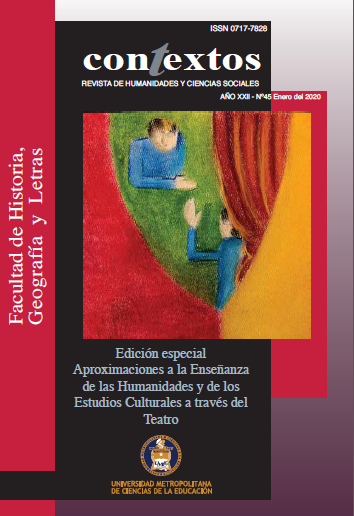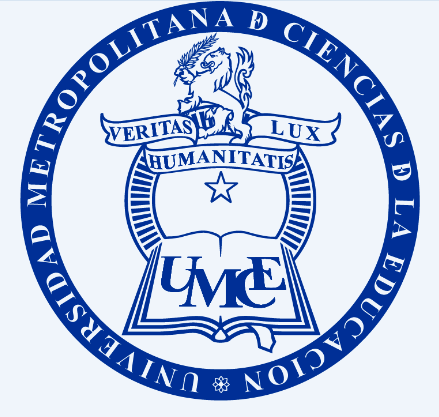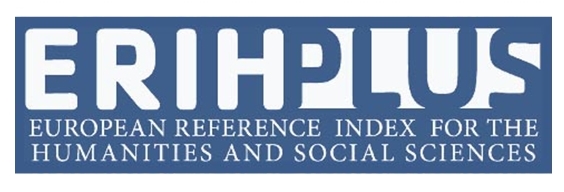Main Article Content
Jul 8, 2019
Abstract
This essay proposes a teaching approach to study Niño Mundo, written by Aurora Mateos, through the development of empathy in the classroom. For this purpose, I suggest the use of the Realistic system of acting developed by theater director and educator, Konstantín Stanislavski, and Lindsay B. Cummings’ research work on the use of dialogue and empathy in theater.
Downloads
Policies for open access journals
Authors who publish here accept the following terms: Authors will keep their copyright and will guarantee the journal the right to the first publication of their work, which will be subject to the Licence of Creative Commons acknowledgement, which allows for the use of this material only if the authorship is credited and the original source is acknowledged (the journal’s URL), and if it is not used with commercial ends and with any derivations of the original work.
Authors may adopt other non-exclusive license agreements of distribution of the published version (e.g. to save it onto a digital institutional archive or publish it in a monographic volume) only if the initial publication of this journal is indicated.
It is permitted and recommended for authors to divulge their work on the Internet (e.g. institutional digital archives or webpage) before and during the submission process, which may lead to interesting exchanges and increase the citations of the publication. (See Open Access Effect).
References
Alcantud, Miguel(director). 2013. Diamantes negros [cinta cinematográfica]. España: Fado Filmes y Potenza Producciones.
Amnistía Internacional. 2018. Informe 2017/2018. La situación de los Derechos Humanosen el mundo. London: Peter Benenson House.
Anónimo. 1996. Lazarillo de Tormes. Madrid: Cátedra.
Anker, Elizabeth. 2012. Fictions of Dignity: Embodying Human Rights in World Literature. Ithaca, NY: Cornell University Press.
Brook, Peter. 2002. La puerta abierta. Reflexiones sobre la interpretación y el teatro.Barcelona: Alba Editorial.
Buñuel, Luis. 1950. Los olvidados [cinta cinematográfica]. México: Ultramar Films.
Cantú Toscano, Mario. 2014. La ciencia en Stanislavski. Una relectura desde susinfluencias científicas. México: Paso de Gato. Colección de Artes Escénicas.
Chiaet, Julianne. 2013. “Novel Finding: Reading Literary Fiction Improves Empathy”. Scientific American[En línea]. Disponible en: https://www.scientificamerican.com/article/novel-finding-reading-literary-fiction-improves-empathy/[Consulta 10/10/2018].
Corcuera, Javier. 2004.Las hijas de Belén [documental]. España: Tus Ojos.
Cummings, Lindsay B. (2016). Empathy as Dialogue in Theatre and Performance. UK: Palgrave Macmilan.
Dickens, Charles. 2008. Oliver Twist or The Parish Boy’s Progress [Libro electrónico]. TheProject Gutenberg. Acceso abierto. Disponible en: https://www.gutenberg.org/files/730/730-h/730-h.htm[Consulta 19/10/2018].
Husserl, Edmund. 1960. Cartesian Meditations, An Introduction to Phenomenology. Trad. Dorion Cairns. The Hauge: Martinus Nijhoff.
Hyatt Edwardm Laura. 2013. “A brief conceptual history of Einfühlung: 18th-Century Germany to Post-World War II U.S. Psychology”. History of Psychology 16.4: 271.
Jorge, Miguel. 2018. “Por qué había niños en pequeñas jaulas exteriores colgando deedificios de Nueva York o Londres”. Gizmodo[En línea]. Disponible en: https://es.gizmodo.com/por-que-habia-ninos-en-pequenas-jaulas-exteriores-colga-1825825643[Consulta 22/10/2018].
Kristeva, Julia.1987. Tales of Love. New York: Columbia University Press.
Lacapra, Dominick. 2004. Historic in Transit: Experience, Identity, Critical Theory. Ithaca:Cornell University Press.
Lagemann, Rudi.2006. Anjos do Sol [cinta cinematográfica]. Brasil: Globo Filmes / Apema Filmes / Caradecão Filmes.
Mansfield, Nick. 2012. “Human Rights as Violence and Enigma: Can Literature Really Be of Any Help with the Politics of Human Rights?” Theoretical Perspectives of Human Rights and Literature. New York: Routledge, pp. 201-2014.
Mateos, Aurora. 2015. Niño mundo. Scotts Valley (CA):CreateSpace IndependentPublishing Platform.
Morris, Lean y Roberto Romano. 2005. Stolen Childhoods [documental]. United States: Galen Films.
Nowak, Magdalena. 2011. "The Complicated History of Einfühlung.” Argument 1 2: 301-26.
Polgovsky, Eugenio. 2008. Los herederos [documental]. México: Tecolote Films.
Rocamora Braceli, Natalia. 2015. La super-estrategia de Stanislavski: motivos de unmétodo para la interpretación del actor contemporáneo. Granada: Universidad deGranada.
Romano, Roberto. 2011. The Harvest / La cosecha [documental]. United States: RoryO’Connor y U. Roberto Romano.
Saura, Jorge. 2015. “Los herederos de Stanislavski”. Acotaciones. 35: 61-83.
Schanberg, Sydney H.1996. “Six Cents an Hour”. Life Magazine [En línea]. Disponible en: https://laborrights.org/in-the-news/six-cents-hour[Consulta 27/10/2018].
Stanislavski, Konstantín. 2009. El trabajo del actor sobre sí mismo en el proceso creadorde la encarnación. Trad. Jorge Saura. Barcelona: Alba.
-----. 1993. El trabajo del actor sobre su papel.Trad. Jorge Saura.Buenos Aires: Quetzal. Colección La Farándula.
-----. 2001. El sistema Stanislavski. Diccionario de términos stanislavskianos. Trad. Ángel Gutiérrez. Murcia: Escuela Superior de Arte Dramático.
-----.2011. La construcción del personaje. Trad. Bernardo Fernández Fernández. Madrid: Alianza Editorial.
-----. 2003. La preparación del actor. Trad. Ricardo Debenedetti. Madrid: Editorial La Avispa.
-----. 1997. Mi vida en el arte. Trad. N. Caplan. Madrid: La Avispa.
Stein, Edith. 1964. On the Problem of Empathy. Trad. Waltrout Stein. The Hague: M. Nijhoff.
Todd, Sharon. 2003. Learning from the Other. Levinas, Psychoanalysis, and Ethical Possibilities in Education. Albany: State University of New York Press.
UNICEF. 2018. “El trabajo infantil”. Unicef para cada niño [En línea]. Disponible en:https://www.unicef.es/noticia/el-trabajo-infantil[Consulta 24/10/2018].
-----. 2018. “Plan de Acción para la Igualdad entre los Géneros para 2018-2021”. Unicefpara cada niño. [En línea]. Disponible en: https://www.unicef.org/es/igualdad-de-genero/plan-de-accion-para-la-igualdad-entre-los-generos-para-2018-2021[Consulta24/10/2018]
V.V.A.A. 2010. “Ted Case Study: Nike: Nike Shoes and Child Labor in Pakistan”. ChinaLabor Watch. [En línea]. Disponible en:http://www.chinalaborwatch.org/newscast/66[Consulta 26/10/2018].
Villaécija, Raquel. 2016. “De la explotación infantil a la batería de los móviles y tabletas”.[En línea]. Disponible en:https://www.elmundo.es/solidaridad/2016/01/19/569dfb40ca474174418b4608.html[Consulta 30/10/2018]
Villena, Miguel Ángel. 2018. “Entrevista a Juan Mayorga: El teatro es el arte de la reunióny cobra fuerza en una época donde todo ocurre en una pantalla”. eldiario.es [En línea]. Disponible en: https://www.eldiario.es/cultura/teatro/espectador-vuelva-regrese-transformado-teatro_0_848666093.html[Consulta 22/12/2018].
Vischer, Robert. 1990. “On the optical Sense of Form: A Contribution to Aesthetics”. En Henry Francis Mallgrave y Eleftherios Ikonomou (eds.), Empathy, Form, and Space. Problems in German Aesthetics, 1893-1983. Santa Monica: Getty Center.






